This is the anterior bone that articulates with the manubrium of the sternum at the sternoclavicular joint.
a) Scapula
b) Clavicle
c) Xiphoid
d) Rib
e) Thoracic vertebra
b
Which of the following bones articulates with the scapula?
- a) Thoracic vertebra
- b) Humerus
- c) Sacrum
- d) Tibia
- e) Sternum
b
Why does a fracture of the clavicle usually occur in the mid-region of the bone?
a) Due to the medial pressure from the inflated lungs
b) Due to the ligament-reinforced strength of the acromial joint
c) Due to weakness at the junction of the two curves of clavicle
d) Due to position of the clavicle relative to the humerus
e) Due to fusion of the ends of the clavicle to the sternum and scapula
c
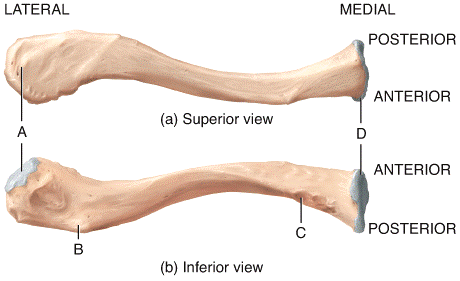
Which part of the clavicle articulates with the manubrium?
- a) A
- b) B
- c) C
- d) D
- e) None of these choices are correct.
d
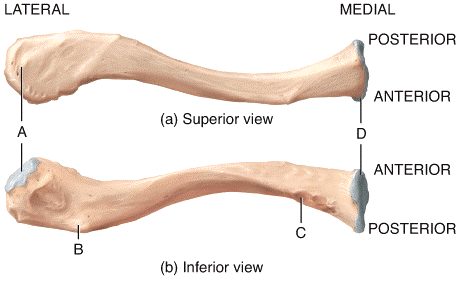
Which is the only part of the clavicle that articulates with the scapula?
- a) A
- b) B
- c) C
- d) D
- e) None of these choices are correct.
a
Which site labeled on the diagram is considered the weakest point of the clavicle?
- a) A b) B c) C d) D e) None of these choices are correct.
e
Which of the following bones is located in the posterior thorax between the levels of second and seventh vertebrae?
- a) Sternum
- b) Clavicle
- c) Pelvis
- d) Scapula
- e) Sacrum
d
Which bone articulates with the scapula at the glenoid cavity?
- a) Ileum
- b) Thoracic vertebra
- c) Sternum
- d) Clavicle
- e) Humerus
e
This is the thick edge of the scapula that is closer to the arm.
a) Axillary border
b) Medial border
c) Infraspinous fossa
d) Coracoid process
e) Acromion
a
Which of the following bone markings on the scapula is an indentation into which the head of the humerus fits?
a) Coracoid process
b) Glenoid cavity
c) Acromion
d) Scapular notch
e) Supraspinous fossa
b
Which of the following statements is TRUE with regard to the human hand?
a) There are 5 carpals, 8 metacarpals and 14 phalanges.
b) There are 8 carpals, 6 metacarpals and 14 phalanges
c) There are 8 carpals, 5 metacarpals and 15 phalanges
d) There are 8 carpals, 5 metacarpals and 14 phalanges
e) There are 5 carpals, 8 metacarpals and 14 phalanges
d
The glenohumeral joint is formed by articulation of the
a) humerus, radius and ulna.
b) humerus and radius.
c) humerus and clavicle.
d) humerus and ulna.
e) humerus and scapula.
e
The epiphyseal line on the proximal end of the humerus is found in the
- a) anatomical neck.
- b) greater tubercle.
- c) intertubercular sulcus.
- d) surgical neck.
- e) olecranon fossa.
a
The capitulum of the humerus articulates with the
- a) radius.
- b) ulna.
- c) scapula.
- d) carpal bones.
- e) clavicle.
a
This is a spool-shaped process on distal end of the humerus that is found medial to the capitulum and articulates with the ulna.
a) Coronoid fossa
b) Trochlea
c) Medial epicondyle
d) Lateral epicondyle
e) Lesser tubercle
b
The medial and lateral epicondyles are found on the distal end of the humerus and are used for
a) formation of the elbow joint.
b) tendon attachment.
c) passage of nerves and blood vessels through the bone into the marrow cavity.
d) Both formation of the elbow joint and tendon attachment.
e) All of these choices are correct.
b
Which of the following structures on the ulna receives the trochlea of the humerus?
- a) Olecranon fossa
- b) Coronoid process
- c) Trochlear notch
- d) Radial notch
- e) Capitulum
c
What is the function of the interosseous membrane between the ulna and radius?
a) Joins the shafts of two bones
b) Tendon attachment
c) Site of bone repair
d) Both site of tendon attachment and bone repair
e) None of these choices are correct.
a
The distal end of the radius articulates with how many bones of the wrist?
a) 1
b) 2
c) 3
d) 4
e) 5
c
Which of the following carpal bones is named for its large hook-shaped projection on its anterior surface?
- a) Lunate
- b) Scaphoid
- c) Triquetrum
- d) Hamate
- e) Pisiform
d
What is included in the carpal tunnel?
- a) Pisiform
- b) Trapezium
- c) Flexor retinaculum
- d) Both pisiform and trapezium.
- e) All of these choices are correct.
e
The carpometacarpal joint consists of the
a) base of metacarpal bones and distal row of carpal bones.
b) base of metacarpal bones and proximal row of carpal bones.
c) head of metacarpal bones and distal row of carpal bones.
d) head of metacarpal bones and proximal row of carpal bones.
e) None of these choices are correct.
a
How many phalanges are in each hand?
a) 10
b) 12
c) 14
d) 16
e) 20
c
The coxal bones unite anteriorly at a joint called the
a) pubic symphysis.
b) sacroiliac joint.
c) hip.
d) acetabulum.
e) None of these choices are correct.
a
What is the function of the pelvic girdle?
a) Support for vertebral column
b) Attachment site for lower limbs
c) Attachment site for large pectoral muscles.
d) Attachment site for lower limbs and for large pectoral muscles.
e) All of these choices are correct.
d
In the standard anatomical position, the _____ is the bone of the pelvis found the most superior.
- a) Ilium
- b) Pubis
- c) Ischium
- d) Both ilium and ishium.
- e) All of these choices are correct.
a
Which of the following is the largest foramen in the human skeleton?
- a) Acetabulum
- b) Obturator foramen
- c) Vertebral foramen
- d) Mental foramen
- e) Foramen magnum
b
Which projection extends superiorly and laterally along the superior ramus of the pubis eventually merging with the arcuate line of the ilium?
a) Pectineal line
b) Ischial tuberosity
c) Anterior gluteal line
d) Inferior gluteal line
e) Greater sciatic notch
b
The hip joint is the joint found between
a) the femur and tibia.
b) the pelvis and sacrum.
c) the pelvis and tibia.
d) the femur and patella.
e) the pelvis and femur.
e
The portion of the bony pelvis that is found inferior to the pelvic brim is called
a) the false pelvis.
b) the greater pelvis.
c) the true pelvis.
d) both the false pelvis and the greater pelvis.
e) all of these choices are correct.
c
In comparison to the male pelvis, the female pelvis is NOT
a) wider.
b) shallower.
c) larger in the pelvic inlet.
d) larger in the pelvic outlet.
e) larger in the acetabulum.
e
32) Each lower limb has
a) 30 bones found in 3 locations.
b) 30 bones found in 4 locations.
c) 32 bones found in 3 locations.
d) 32 bones found in 4 locations.
e) 34 bones found in 4 locations
b
Which process on the femur serves as an attachment point for tendons of several thigh muscles?
- a) Gluteal tuberosity
- b) Linea aspera
- c) Medial epicondyle
- d) Both gluteal tuberosity and linea aspera
- e) Both linea aspera and medial epicondyle
d
Which of the following markings is located on the medial side of the femur?
a) Lesser trochanter
b) Greater trochanter
c) Gluteal tuberosity
d) Lateral epicondyle
e) Linea aspera
a
Which bone develops in the tendon of the quadriceps femoris muscle and protects the knee joint?
- a) Ischium
- b) Ilium
- c) Pubis
- d) Patella
- e) Femur
d
The medial and lateral condyles of the femur fit into what part of the patella?
a) Articular facets
b) Base of the patella
c) Tibiofemoral crest
d) Apex of the patella
e) None of these choices are correct.
a
Which of the structures listed below is NOT part of the knee joint?
a) Lateral condyle of the femur
b) Medial condyle of the femur
c) Lateral malleolus of the fibula
d) Condyles of the tibia
e) Patella
c
The hard sharp ridge of the shin that can easily be felt below the skin is the
a) anterior border (crest) of the tibia.
b) tibial tuberosity.
c) medial condyle of the tibia.
d) tibiofemoral joint.
e) intercondylar eminence.
a
The lateral malleolus is found on the distal end of what bone?
- a) Tibia
- b) Fibula
- c) Talus
- d) Metatarsals
- e) Femur
b
Which of following bones is NOT a tarsal bone?
- a) Talus
- b) Calcaneus
- c) Navicular
- d) Cuneiform
- e) Capitate
e
Which of the followings structures is not found in the foot?
a) Pollex
b) Hallux
c) Talus
d) Longitudinal arch
e) Transverse arch
a
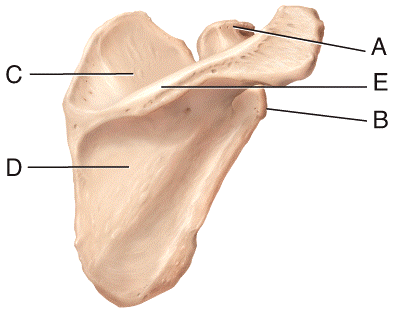
Which of the labeled structures in the diagram serve as attachment sites for tendons of the shoulder muscles?
- a) A, B
- b) B, C, D
- c) A, B, C,
- d) A, B, C, D
- e) A, C, D, E
e
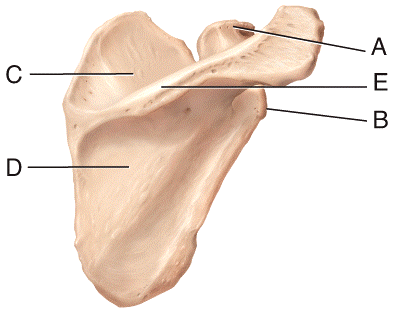
43) Which of the labeled structures in the diagram is the coracoid process?
- a) A
- b) B
- c) C
- d) D
- e) E
a
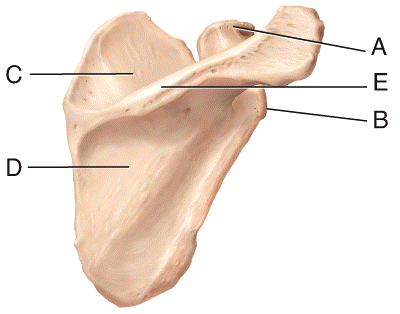
Which of the labeled structures in the diagram is the supraspinous fossa?
- a) A
- b) B
- c) C
- d) D
- e) E
c
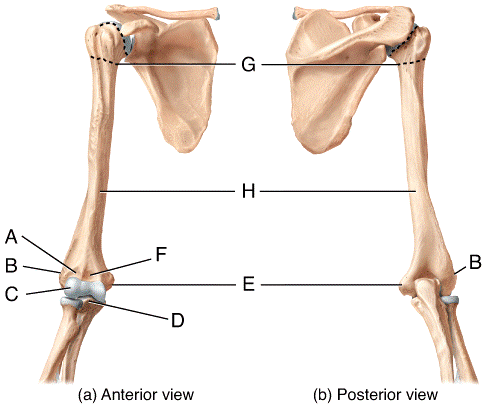
In the diagram of the humerus, which is the lateral epicondyle?
- a) A
- b) B
- c) F
- d) G
- e) H
b
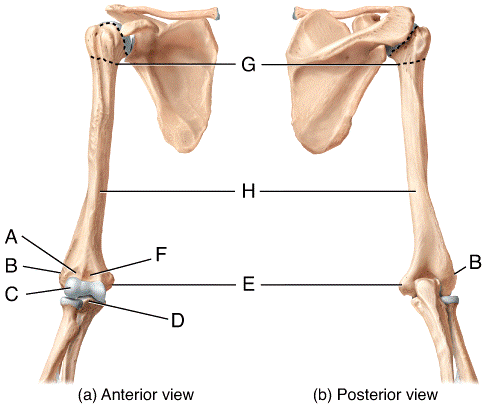
In the diagram of the humerus, this structure receives the head of the radius when the forearm is flexed.
- a) A
- b) B
- c) C
- d) D
- e) F
e
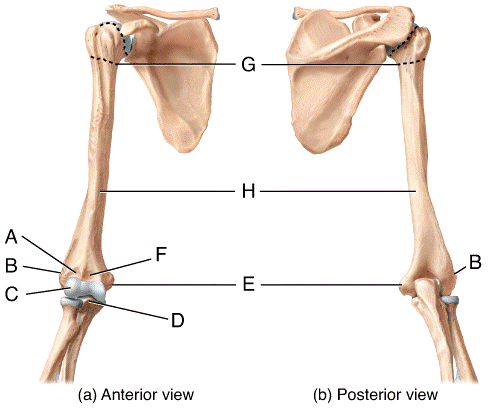
In the diagram of the humerus, where is the trochlea?
- a) B
- b) C
- c) D
- d) E
- e) F
c
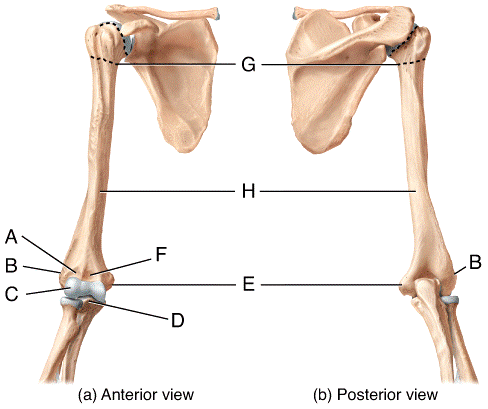
In the diagram of the ulna and radius, where is the styloid process of the radius?
- a) A
- b) B
- c) E
- d) F
- e) None of these choices are correct.
c
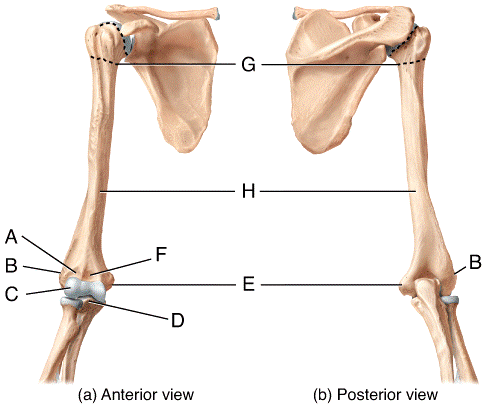
In the diagram of the ulna and radius, where is the radial tuberosity?
- a) A
- b) B
- c) E
- d) F
- e) None of these choices are correct.
b
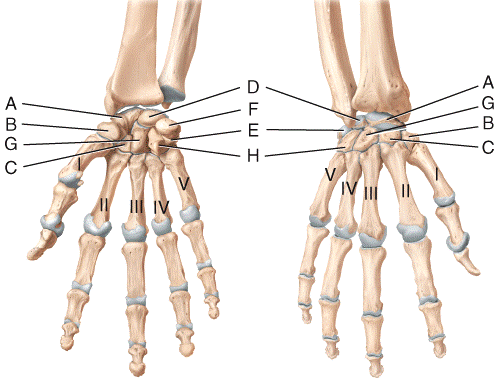
In the diagram of the wrist and hand, where is the capitate bone?
- a) D
- b) E
- c) F
- d) G
- e) H
d
In the diagram of the wrist and hand, where is the trapezoid bone?
- a) A
- b) B
- c) C
- d) D
- e) E
c
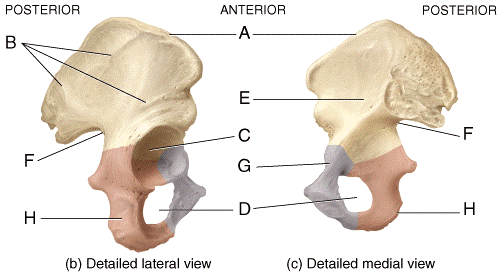
Which structure in the pelvis is where the longest nerve in the body passes?
a) C
b) D
c) F
d) G
e) H
c
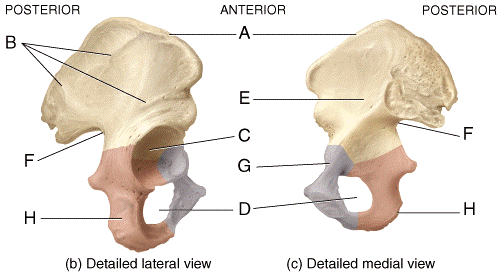
In the diagrams of the pelvis, where is the ischial tuberosity?
- a) E
- b) F
- c) G
- d) H
- e) Not labeled in the diagrams
d
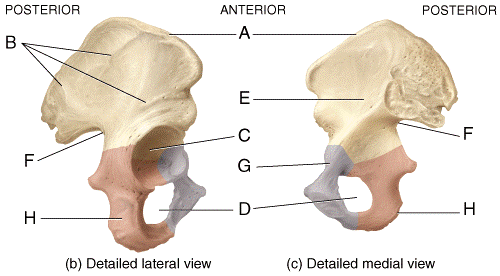
Which labeled structure in the diagrams of the pelvis terminates anteriorly as the anterior superior iliac spine?
- a) A
- b) B
- c) C
- d) D
- e) H
a
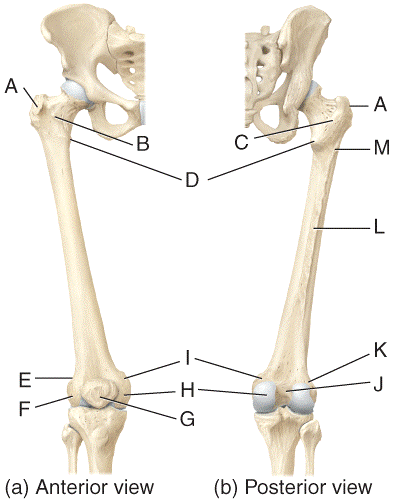
Which of the labeled structures of the femur serve as points of attachment for the tendons of thigh and buttocks muscles?
- a) A, B
- b) A, B, C
- c) A, D
- d) A, B, M
- e) D, M, L
c
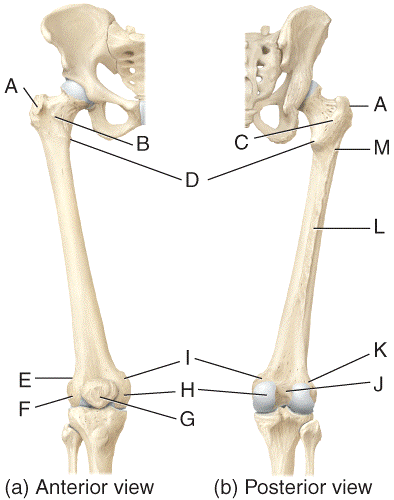
In the diagram of the femur, where is the medial condyle?
- a) E
- b) F
- c) G
- d) H
- e) I
d
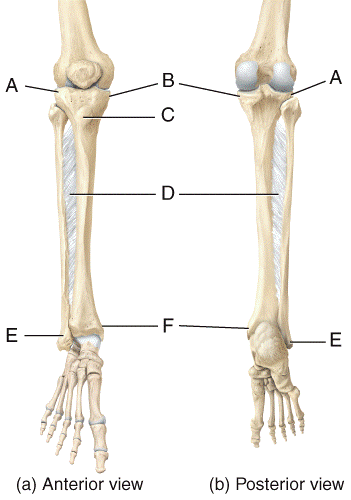
In the diagram of the tibia and fibula, where is the tibial tuberosity?
- a) B
- b) C
- c) E
- d) F
- e) G
b
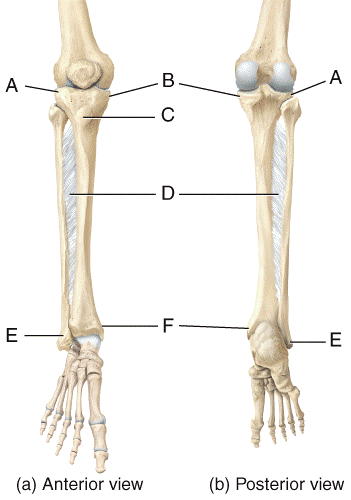
In the diagram of the tibia and fibula, this structure articulates with the talus and forms a protrusion on the medial surface of the ankle.
- a) E
- b) F
- c) G
- d) Both E and F
- e) All of these choices are correct.
b
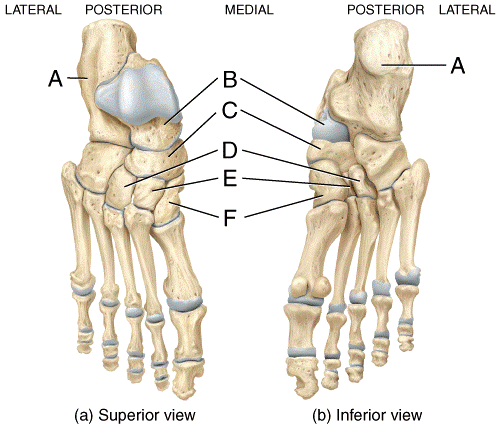
In the diagram of the foot, where is the navicular?
- a) A
- b) B
- c) C
- d) D
- e) E
c
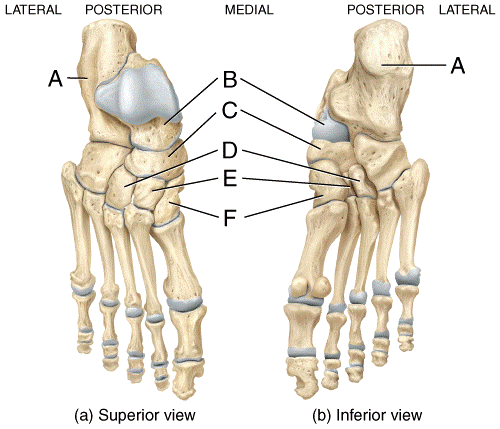
Which labeled bone in the diagram of the foot is the largest and strongest tarsal bone?
- a) A
- b) B
- c) C
- d) D
- e) E
a
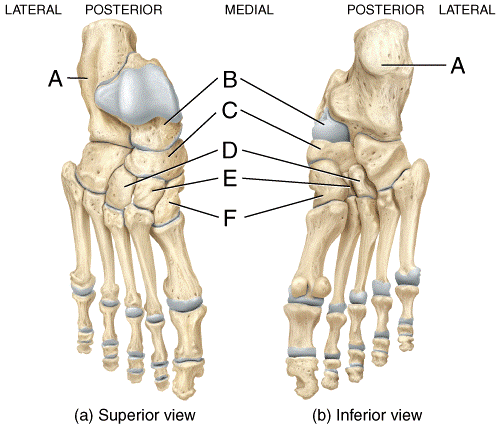
Which labeled bone in the diagram of the foot is the only bone of the foot that articulates with the fibula and tibia?
- a) A
- b) B
- c) C
- d) D
- e) E
b
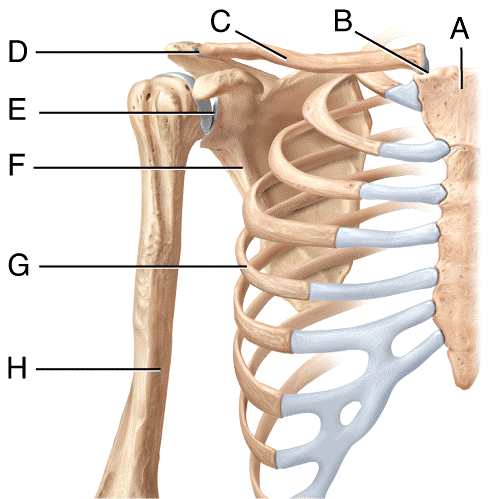
The pectoral girdle consists of 2 bones labeled _____ and _____ in the diagram.
- a) A and B
- b) A and G
- c) C and F
- d) F and H
- e) E and F
c
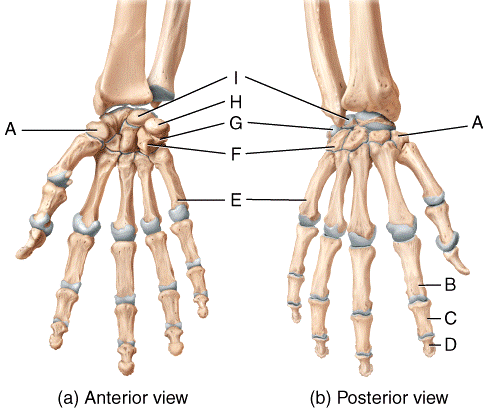
Where on the diagram is a metacarpal bone?
a) A
b) B
c) D
d) E
e) I
d
This is a common condition experienced by runners, which is caused by the kneecap tracking laterally as well as inferiorly and superiorly.
a) Patellofemoral stress syndrome
b) Metatarsal microfracture
c) Bunions
d) Hallux valgus
e) Plantar fasciitis
a
Which of the following is a condition where the medial longitudinal arch of the foot is decreased, resulting in fallen arches?
a) Patellofemoral stress syndrome
b) Bunions
c) Flatfoot
d) Clawfoot
e) Clubfoot
c
Which of the following is a condition where the foot is twisted inferiorly and medially, and the angle of the arch is increased?
a) Patellofemoral stress syndrome
b) Bunions
c) Flatfoot
d) Clawfoot
e) Clubfoot
e
During embryonic and fetal develop, most skeletal tissues arise from
a) the neurocranium.
b) the notochord.
c) mesenchymal cells.
d) endoderm.
e) none of these choices are correct.
c
The neurocranium gives rise to bones of the
- a) upper limbs
- b) lower limbs
- c) face
- d) ribcage
- e) skull
e
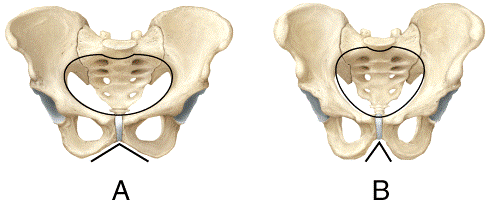
Which pelvis in the diagram shows the characteristics of a female pelvis?
- a) A
- b) B
c) Both are male.
a
The boundary between the true pelvis and the false pelvis is the
- a) pelvic axis.
- b) pubic symphysis.
- c) pelvic outlet.
- d) pelvic brim.
- e) pectineal line.
d
The boundary between the true pelvis and the false pelvis is the
- a) pelvic axis.
- b) pubic symphysis.
- c) pelvic outlet.
- d) pelvic brim.
- e) pectineal line.
d
Which of the following is NOT a way that the skeletal system contributes to homeostasis?
a) Provides support and protection for internal organs.
b) Stores and releases sodium ions.
c) Houses blood forming tissue.
d) Protects the brain and spinal cord.
e) Serves as attachment and leverage points for muscles.
b